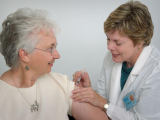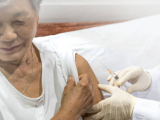Jul 23, 2009 (CIDRAP News) – The Food and Drug Administration (FDA) may review vaccines for the novel H1N1 influenza virus the same way it evaluates the annual updates of seasonal flu vaccines, which would probably lead to faster FDA approval than occurs with brand-new products, an FDA official said in the wake of an FDA advisory committee meeting today.
FDA spokeswoman Peper Long said the FDA's Vaccines and Related Biological Products Advisory Committee (VRBPAC) expressed support for an FDA staff recommendation to handle the H1N1 vaccines the way seasonal flu vaccines are handled. The committee met today to publicly air H1N1 vaccine issues.
Five companies—Sanofi Pasteur, Novartis, CSL Ltd., GlaxoSmithKline (GSK), and MedImmune—are rushing to make H1N1 influenza vaccines for the US government and are launching or preparing to launch clinical trials. US officials want trial data as soon as possible so they can approve vaccines in time for a potential renewed surge of the virus this fall after children return to school.
The committee didn't make a formal recommendation about how to regulate the new vaccines, but a consensus in favor of using the seasonal vaccine approach emerged, Long told CIDRAP News.
Long noted that manufacturers with established seasonal flu vaccines file a supplemental application each year after changing one or more of the three flu strains in the vaccine, in line with FDA recommendations. A "strain change supplement" usually doesn't require new clinical data, though some immunogenicity and safety data usually are available, she said.
The other licensing pathways for vaccines are to file a biologics license application (BLA), involving a formal process with full clinical trials, or to seek an emergency use authorization (EUA). In declared public health emergencies, the FDA can provide an EUA for products whose effectiveness has not yet been fully demonstrated.
"The third way is a strain change supplement, which is how flu vaccines are approved every year," Long said. "That doesn't usually require new clinical data."
"A strain change supplement will allow us to license a vaccine based on our experience evaluating vaccines over the years, so if necessary we can have a vaccine ready to go," she said. With clinical trials starting now, some results are likely to be available by the time the vaccine is needed, she added.
"We'll start to see some first-round data by September," Long said.
The committee "pretty well agreed" with the strain change regulatory approach, she said. However, she said this approach would be possible only for vaccines that are not paired with dose-sparing adjuvants.
The government has ordered supplies of adjuvants made by Novartis and GSK, but no US-licensed vaccines contain those adjuvants and, hence, their use will require special testing and evaluation.
Long said a GSK official at today's meeting discussed plans to test the company's vaccine with an adjuvant. "That couldn't be approved as a strain change supplement with FDA; that would have to fall under a regular BLA or an emergency use authorization," she said.
She emphasized that a final decision on how to regulate the H1N1 vaccines will be up to the secretary of the Department of Health and Human Services and that the proposal to use the strain-change approach assumes that H1N1 vaccines will be needed before full clinical testing can be completed.
"We're preparing for a lot of contingencies, and each step along the way is its own risk-benefit analysis," she commented.
The five vaccine makers are all growing their vaccines in chicken eggs, the conventional production method in use for decades. Four of the five are dealing with low yields of the vaccine—half or less of what they typically get with seasonal flu vaccines, according to recent reports.
However, MedImmune is getting a much better yield with its live attenuated vaccine, which is given as a nasal spray. Company officials who were at today's meeting said they could make more doses than they have spray bottles to deliver, according to an Associated Press report.
See also:
Jul 23 VRBPAC meeting information

















